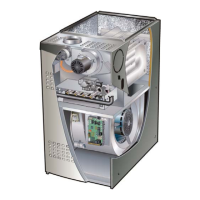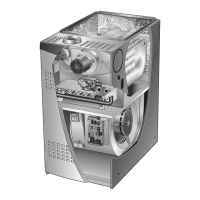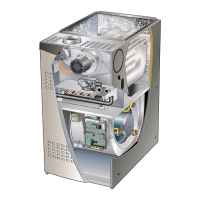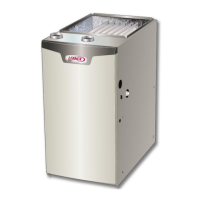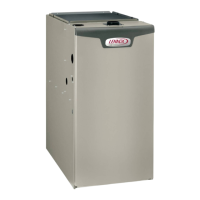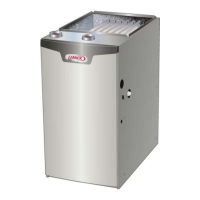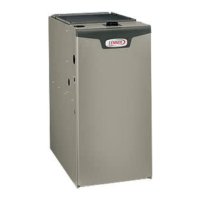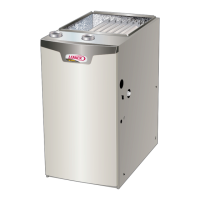Page 27
Gas supply piping should not allow more than 0.5”W.C.
drop in pressure between gas meter and unit. Supply gas
pipe must not be smaller than unit gas connection. Com-
pounds used on gas piping threaded joints should be re-
sistant to action of liqueed petroleum gases.
C-Testing Gas Piping
WARNING
In case emergency shutdown is required, turn o
the main shut-o valve and disconnect the main
power to unit. These controls should be properly
labeled by the installer.
When pressure testing gas lines, the gas valve must be
disconnected and isolated. Gas valves can be damaged if
subjected to more than 0.5 psig (14” W.C.). See FIGURE
20. If the pressure is greater than 0.5psig (14”W.C.), use
the manual shut-o valve before pressure testing to iso-
late furnace from gas supply.
MANUAL MAIN SHUT-OFF VALVE
WILL NOT HOLD TEST PRESSURE
IN EXCESS OF 0.5 PSIG (14”W.C.)
GAS VALVE
CAP
GAS PIPING TEST PROCEDURE
FIELD PROVIDED
1/8 NPT PLUG
FIGURE 20
When checking piping connections for gas leaks, use
preferred means. Kitchen detergents can cause harmful
corrosion on various metals used in gas piping. Use of a
specialty Gas Leak Detector is strongly recommended. It
is available through Lennox under part number 31B2001.
See Corp. 8411-L10, for further details.
Do not use matches, candles, ame or any other
source of ignition to check for gas leaks.
D-Testing Gas Supply Pressure
A threaded plug on the inlet side of the gas valve provides
access to the supply pressure tap. Remove the thread-
ed plug, install a eld-provided barbed tting and connect
a manometer to measure supply pressure. See table 14
for supply line pressure. Replace the threaded plug after
measurements have been taken.
E-Check Manifold Pressure
After line pressure has been checked and adjusted, check
manifold pressure. Checks of manifold pressure are made
as verication of proper regulator adjustment. Manifold
pressure for the EL280UHE(X) can be measured at any
time the gas valve is open and is supplying gas to the unit.
IMPORTANT
For safety, connect a shut-o valve between the
manometer and the gas tap to permit shut o of gas
pressure to the manometer.
The gas valve is factory set and should not require adjust-
ment. All gas valves are factory regulated.
Manifold Adjustment Procedure:
NOTE - Pressure test adapter kit (10L34) is available from
Lennox to facilitate manifold pressure measurement.
1 - Connect test gauge to manifold pressure post
(FIGURE 19) on gas valve.
2 - Ignite unit on low re and let run for 5 minutes to
allow for steady state conditions.
3 - After allowing unit to stabilize for 5 minutes, record
manifold pressure and compare to value given in
table 14.
4 - If necessary, make adjustments. Figure 18 show
location of high re and low re adjustment screw.
5 - Repeat steps 2, 3 and 4 on high re.
6 - Shut unit o and remove manometer as soon as an
accurate reading has been obtained. Take care to
replace pressure tap plug.
7 - Start unit and perform leak check. Seal leaks if
found.
F- Proper Gas Flow (Approximate)
Furnace should operate at least 5 minutes before check-
ing gas ow. Determine time in seconds for two revolu-
tions of gas through the meter. (Two revolutions assures
a more accurate time.) Divide by two and compare to time
in TABLE 12 below. If manifold pressure matches TABLE
14 and rate is incorrect, check gas orices for proper size
and restriction.
NOTE- To obtain accurate reading, shut o all other gas
appliances connected to meter.
TABLE 12
GAS METERING CLOCKING CHART
Input
Natural 1000 btu/
cu ft
LP 2500 btu/cu ft
Seconds For One Revolution
1 cu ft
dial
2 cu fr
dial
1 cu ft
Dial
2 cu ft
Dial
-045 80 160 200 400
-070 55 110 136 272
-090 41 82 102 204
-110 33 66 82 164
IMPORTANT
For safety, shut unit o and remove manometer as
soon as an accurate reading has been obtained.
Take care to replace pressure tap plug.
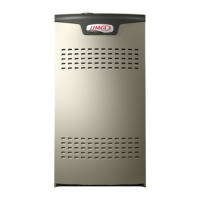
